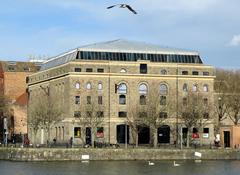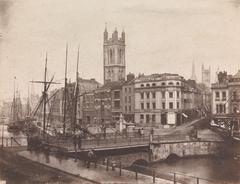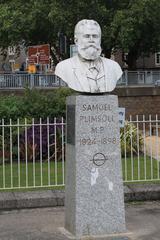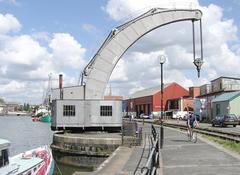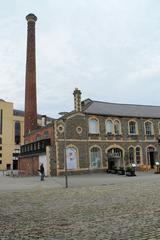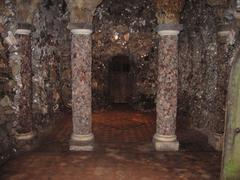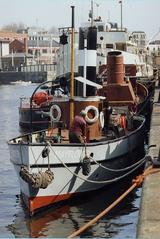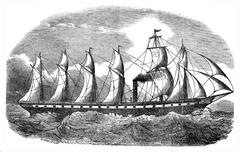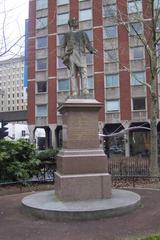
Fire-Float Pyronaut Visiting Hours, Tickets, and Bristol Historical Sites Guide
Date: 04/07/2025
Introduction: Bristol’s Floating Fire-Fighting Icon
Moored on Bristol’s vibrant Floating Harbour, the Fire-Float Pyronaut stands as a proud testament to the city’s maritime innovation and resilience. Commissioned in 1934, this unique vessel was purpose-built to tackle the ever-present threat of fire in Bristol’s bustling port—a role it fulfilled with distinction, most famously during the Bristol Blitz of World War II. Fully restored and designated as part of the National Historic Fleet, Pyronaut now offers visitors an immersive journey into Bristol’s industrial past, featuring guided tours, live demonstrations, and a window into the evolution of maritime fire-fighting. Whether you’re passionate about maritime engineering, local history, or simply seeking a memorable day out, use this guide to plan your visit, discover Pyronaut’s story, and explore nearby Bristol historical sites (Wikipedia; National Historic Ships; M Shed).
Contents
- Introduction
- Pyronaut’s Origins and Construction
- Wartime Service: The Bristol Blitz
- Postwar Operations and Technological Upgrades
- Preservation, Museum Life, and Today’s Visitor Experience
- Visiting Pyronaut: Hours, Tickets, and Accessibility
- Special Events, Guided Tours, and Boat Trips
- Nearby Bristol Historical Sites and Travel Tips
- Frequently Asked Questions (FAQ)
- Summary and Travel Tips
- References
Pyronaut’s Origins and Construction
The vessel now known as Pyronaut began her life as Bristol Phoenix II, constructed at the Albion Dock by Charles Hill & Sons Ltd. in 1934 (Wikipedia). Designed to serve as a floating fire engine for the City Docks, she addressed the acute fire risks posed by densely packed ships and warehouses. Her original power came from two Petter Atomic diesel engines and she was equipped with Merryweather & Sons pumps, capable of delivering 500 imperial gallons of water per minute (Wikipedia).
A naming conflict with another vessel led to the adoption of the name “Pyronaut” in 1938—a suggestion by the son of the Watch Committee’s chairman (Wikipedia). Quickly, Pyronaut became a vital part of Bristol’s emergency response, combating fires at major industrial sites in her early years (National Historic Ships).
Wartime Service: The Bristol Blitz
Pyronaut’s most critical role unfolded during World War II, particularly the Bristol Blitz (1940–41), when German bombing raids targeted the docks and surrounding warehouses. Staffed by a dedicated crew, Pyronaut’s round-the-clock operations were pivotal in saving infrastructure and lives (National Historic Ships; M Shed). Notably, Pyronaut’s ability to draw and deliver large volumes of water from the harbour made her indispensable in tackling catastrophic fires, such as the one at Samuel Thompson & Sons’ malthouse in 1938 (Wikipedia).
Postwar Operations and Technological Upgrades
After the war, Pyronaut continued to serve, responding to major incidents including the Bristol Hippodrome fire (1948), a wastepaper fire at St. Anne’s Board Mill (1949), and the Avonmouth oil fire (1951) where she pumped water continuously for two days (Backstage Bristol; Wikipedia). In 1968–69, Pyronaut underwent a major refit: her original engines and pumps were replaced, doubling her capacity to 1,000 imperial gallons per minute and ensuring continued relevance as commercial shipping shifted toward Avonmouth (Wikipedia).
Pyronaut was retired in 1973 as activity in the city docks declined. An incomplete conversion attempt to a diver’s boat was followed by a period in private hands, before her acquisition and restoration by Bristol Museums in 1989 (National Historic Ships).
Preservation, Museum Life, and Today’s Visitor Experience
Fully restored, Pyronaut has become a centrepiece of Bristol’s maritime heritage. She is berthed outside the M Shed museum, an institution dedicated to the city’s industrial and social history (M Shed). Listed as part of the National Historic Fleet, Pyronaut remains operational for select events, such as the Bristol Harbour Festival, offering dramatic water displays that captivate visitors (Thornbury History). As an exhibit, she provides a tangible link to Bristol’s past, supported by interpretive panels, guided tours, and educational programmes.
Visiting Pyronaut: Hours, Tickets, and Accessibility
Location: The Pyronaut is moored at Princes Wharf, outside the M Shed on Bristol’s Floating Harbour. The area is accessible by foot, bike, or public transport, with Bristol Temple Meads station a 20-minute walk away (M Shed).
Visiting Hours:
- Pyronaut is generally accessible for viewing from the quayside during M Shed opening hours: Tuesday–Sunday, 10:00 AM–5:00 PM.
- On-board access and trips are available only during special events and select weekends. Schedules can be found on the M Shed events calendar.
Tickets:
- Quayside viewing is free.
- Tickets are required for guided tours and boat trips (typically £8–£12 for adults, with discounts for children and families).
- Book in advance via the M Shed website or by phone.
Accessibility:
- The quayside and M Shed are wheelchair accessible.
- Due to Pyronaut’s historic design (narrow gangways, steps), on-board access may be restricted. Contact M Shed’s accessibility team for specific arrangements.
Facilities:
- Toilets (including accessible toilets) are available at M Shed.
- Café, gift shop, and picnic spots nearby.
- Assistance dogs welcome.
Special Events, Guided Tours, and Boat Trips
Live Demonstrations and Trips:
- During festivals and select weekends, Pyronaut operates short harbour trips with water cannon displays (National Historic Ships; Time Out).
- Trips typically last 30–45 minutes, starting from 11:00 AM (subject to volunteer crew, vessel condition, and weather).
Volunteer-Led Experience:
- Pyronaut is run by dedicated volunteers. Schedules may change—check updates online or at the museum (Secret Bristol).
Educational Programmes:
- School groups and families can engage with interpretive displays and hands-on learning about fire-fighting technology and Bristol’s docks (VisitSights).
Nearby Bristol Historical Sites and Travel Tips
Combine Your Visit:
- M Shed Museum: Free entry, exploring Bristol’s industrial and social history (M Shed).
- SS Great Britain: A pioneering ocean liner and immersive museum experience.
- Bristol Harbour: Boat tours, historic pubs, and public art.
- Queen Square & Castle Park: Green spaces with rich history.
Travel Tips:
- Arrive early—harbourside can get busy.
- Use public transport or walk—parking is limited.
- Dress for the weather; trips may be cancelled in poor conditions.
- Photography is welcome during trips and demonstrations.
Frequently Asked Questions (FAQ)
Q: When can I visit the Pyronaut?
A: Quayside viewing is possible during M Shed hours (Tues–Sun, 10:00–5:00). On-board visits and trips are available during special events—check the M Shed events calendar.
Q: How do I buy tickets?
A: Purchase tickets for tours and trips online via the M Shed website or by phone. Advance booking is recommended.
Q: Is the Pyronaut accessible?
A: The quayside and museum are accessible. On-board access is limited—contact M Shed for details.
Q: Are trips always available?
A: Trips depend on volunteer crew, vessel condition, and weather. Schedules may change without notice.
Q: Can I take photographs?
A: Personal photography is encouraged. For commercial use, seek museum permission.
Summary and Travel Tips
The Fire-Float Pyronaut remains a living emblem of Bristol’s maritime legacy, from her heroic service during the Bristol Blitz to her role today as a dynamic museum exhibit. With free quayside access, engaging tours, and spectacular water displays during special events, Pyronaut offers a uniquely Bristolian experience for history buffs, families, and visitors alike. To make the most of your visit:
- Check M Shed’s website for up-to-date visiting hours and event schedules.
- Book tickets in advance for boat trips and guided tours.
- Explore nearby attractions to enrich your day on the harbourside.
- Download the Audiala app for audio guides and timely event notifications.
Witness Bristol’s floating heritage come alive aboard one of the city’s most treasured vessels.
References
- National Historic Ships: Pyronaut Fire-Float
- Wikipedia: Fire-float Pyronaut
- M Shed Bristol Museum Official Website
- Pyronaut Trips Are Back Summer M Shed, National Historic Ships Event
- RouteYou: Fire-Float Pyronaut Location and Visitor Information
- Time Out Bristol: Pyronaut Trips and Tours
- Backstage Bristol: Pyronaut 90th Birthday Celebrations
- Thornbury History: Pyronaut Report
- WhichMuseum: M Shed Bristol Overview
- Secret Bristol: M Shed Train Rides and Pyronaut Trips
For additional details, high-quality images, and interactive maps, visit the M Shed website or download the Audiala app for the latest updates.




